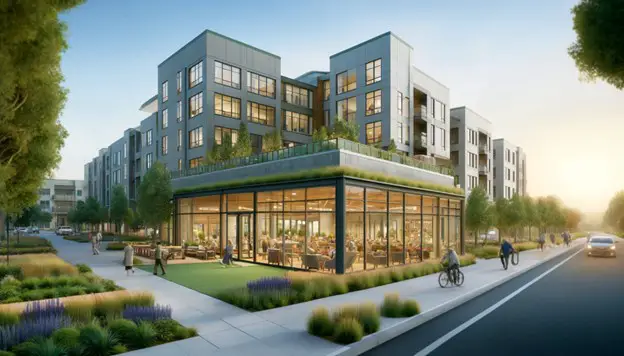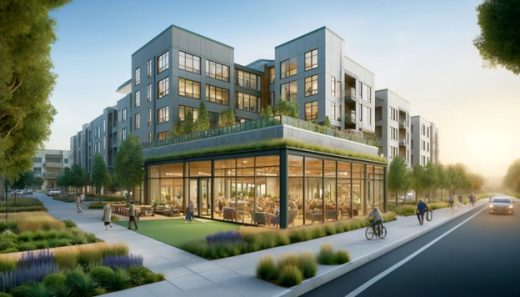Assisted living facilities in San Francisco evolution guide, SF real estate for elderly individuals
The Evolution of Assisted Living Facilities: A Focus on San Francisco
May 15, 2024
Assisted living facilities have become an essential part of senior care, providing a balance between independence and support for elderly individuals. Over the years, the construction and design of these facilities have evolved significantly, reflecting changes in architectural trends, medical care practices, and societal attitudes towards aging. This article explores how assisted living facilities are built and how they have transformed over time, using San Francisco as a case study.
The Fundamentals of Building Assisted Living Facilities
Building an assisted living facility involves careful planning and consideration to meet the needs of its residents. The process typically includes site selection, architectural design, regulatory compliance, and construction.
Site Selection
Choosing the right location is crucial. In San Francisco, factors such as accessibility, proximity to healthcare services, and the availability of public transportation are vital. The site must also comply with zoning laws and environmental regulations.
Architectural Design
The design of assisted living facilities has evolved to prioritize both functionality and aesthetics. Modern facilities are designed to be welcoming and home-like, with features that promote social interaction and physical activity. Common areas, such as dining rooms, lounges, and gardens, are integral parts of the design. Safety features, including handrails, non-slip flooring, and emergency call systems, are also essential.
Regulatory Compliance
Assisted living facilities must adhere to strict regulatory standards to ensure the safety and well-being of residents. In California, the Department of Social Services oversees these regulations, which cover aspects such as staffing ratios, resident rights, and building safety.
Construction
The construction phase involves collaborating with contractors, engineers, and designers to bring the architectural plans to life. This phase focuses on ensuring that the building is not only aesthetically pleasing but also structurally sound and safe for residents.
Historical Development of Assisted Living Facilities
The concept of assisted living has changed significantly over the decades, with shifts in both design philosophy and care practices.
Early Assisted Living Facilities
In the early 20th century, senior care facilities were often austere and institutional. These early facilities prioritized medical care over comfort, with a focus on efficiency rather than resident well-being. Facilities were typically located in urban areas to ensure access to hospitals and medical services.
Mid-20th Century Changes
By the mid-20th century, there was a shift towards more personalized care. The 1950s and 1960s saw the emergence of the nursing home model, which provided both medical care and assistance with daily activities. These facilities began to incorporate more homely elements, but they still often felt clinical and impersonal.
Modern Assisted Living Facilities
Today, assisted living facilities are designed with a holistic approach that emphasizes quality of life. Modern facilities in San Francisco and beyond offer a wide range of amenities, from fitness centers and swimming pools to art studios and theaters. The goal is to create environments that support physical health, social engagement, and mental well-being.
Innovations in San Francisco’s Assisted Living Facilities
San Francisco has been at the forefront of innovation in the design and construction of assisted living facilities. The city’s unique blend of urban living and natural beauty provides a rich environment for developing state-of-the-art senior care facilities.
Sustainable Building Practices
San Francisco is known for its commitment to sustainability, and this is reflected in its assisted living facilities. Many new buildings incorporate green building practices, such as energy-efficient lighting, solar panels, and sustainable materials. These practices not only reduce the environmental impact but also create healthier living environments for residents.
Technology Integration
Modern assisted living facilities in San Francisco are leveraging technology to enhance care and improve quality of life. Features such as smart home systems, telehealth services, and electronic health records are becoming standard. These technologies enable better monitoring of resident health, facilitate communication with healthcare providers, and provide greater convenience and safety.
Community Integration
Newer facilities are designed to integrate more seamlessly with the surrounding community. This includes easy access to local amenities, such as parks, shops, and cultural venues. By fostering a sense of community, these facilities help residents stay engaged and connected with the broader society.
Comparing Old and New Assisted Living Facilities
To illustrate the changes in assisted living facilities over time, here is a comparison of key features:
| Feature | Early Facilities | Modern Facilities |
| Design Philosophy | Institutional and clinical | Home-like and welcoming |
| Location | Urban, near hospitals | Mixed-use, community-integrated |
| Amenities | Basic medical care, minimal social spaces | Fitness centers, art studios, gardens, theaters |
| Sustainability | Limited consideration | Energy-efficient, use of sustainable materials |
| Technology | Minimal use | Smart home systems, telehealth, electronic records |
| Resident Engagement | Low emphasis on social activities | High emphasis on social and recreational programs |
To Finish
The evolution of assisted living facilities reflects broader changes in society’s approach to aging and senior care. From the early, institutional models to today’s vibrant, community-integrated facilities, the focus has shifted towards creating environments that enhance the quality of life for residents.
San Francisco exemplifies this progression, with its innovative designs, sustainable practices, and integration of technology. As the needs and expectations of seniors continue to evolve, assisted living facilities will undoubtedly continue to adapt, ensuring that they remain safe, comfortable, and enriching places for older adults to live.
Comments on this guide to Assisted living facilities in San Francisco evolution article are welcome.
San Francisco Houses : Residences
SF Houses – latest Bay Area architecture, Northern California, USA
San Francisco Architecture Designs – chronological list
Robin Williams Sea Cliff Mansion
Design: jones | haydu
Dolores Heights Residence
Russian Hill
Design: Levy Art + Architecture
Russian Hill Residences
Architects and Architecture
Architects and Architecture by Type – architectural selection below:
Comments / photos for the Assisted living facilities in San Francisco evolution page welcome.






